Transcend SSD320 & SSD720 (256GB) Review
by Kristian Vättö on January 25, 2013 11:31 AM ESTAnandTech Storage Bench 2011
Last year we introduced our AnandTech Storage Bench, a suite of benchmarks that took traces of real OS/application usage and played them back in a repeatable manner. Anand assembled the traces out of frustration with the majority of what we have today in terms of SSD benchmarks.
Although the AnandTech Storage Bench tests did a good job of characterizing SSD performance, they weren't stressful enough. All of the tests performed less than 10GB of reads/writes and typically involved only 4GB of writes specifically. That's not even enough exceed the spare area on most SSDs. Most canned SSD benchmarks don't even come close to writing a single gigabyte of data, but that doesn't mean that simply writing 4GB is acceptable.
Originally we kept the benchmarks short enough that they wouldn't be a burden to run (~30 minutes) but long enough that they were representative of what a power user might do with their system. Later, however, we created what we refer to as the Mother of All SSD Benchmarks (MOASB). Rather than only writing 4GB of data to the drive, this benchmark writes 106.32GB. This represents the load you'd put on a drive after nearly two weeks of constant usage. And it takes a long time to run.
1) The MOASB, officially called AnandTech Storage Bench 2011—Heavy Workload, mainly focuses on the times when your I/O activity is the highest. There is a lot of downloading and application installing that happens during the course of this test. Our thinking was that it's during application installs, file copies, downloading, and multitasking with all of this that you can really notice performance differences between drives.
2) We tried to cover as many bases as possible with the software incorporated into this test. There's a lot of photo editing in Photoshop, HTML editing in Dreamweaver, web browsing, game playing/level loading (Starcraft II and WoW are both a part of the test), as well as general use stuff (application installing, virus scanning). We included a large amount of email downloading, document creation, and editing as well. To top it all off we even use Visual Studio 2008 to build Chromium during the test.
The test has 2,168,893 read operations and 1,783,447 write operations. The IO breakdown is as follows:
| AnandTech Storage Bench 2011—Heavy Workload IO Breakdown | ||||
| IO Size | % of Total | |||
| 4KB | 28% | |||
| 16KB | 10% | |||
| 32KB | 10% | |||
| 64KB | 4% | |||
Only 42% of all operations are sequential; the rest ranges from pseudo to fully random (with most falling in the pseudo-random category). Average queue depth is 4.625 IOs, with 59% of operations taking place in an IO queue of 1.
Many of you have asked for a better way to really characterize performance. Simply looking at IOPS doesn't really say much. As a result we're going to be presenting Storage Bench 2011 data in a slightly different way. We'll have performance represented as Average MB/s, with higher numbers being better. At the same time we'll be reporting how long the SSD was busy while running this test. These disk busy graphs will show you exactly how much time was shaved off by using a faster drive vs. a slower one during the course of this test. Finally, we will also break out performance into reads, writes, and combined. The reason we do this is to help balance out the fact that this test is unusually write intensive, which can often hide the benefits of a drive with good read performance.
There's also a new light workload for 2011. This is a far more reasonable, typical every day use case benchmark. It has lots of web browsing, photo editing (but with a greater focus on photo consumption), video playback, as well as some application installs and gaming. This test isn't nearly as write intensive as the MOASB but it's still multiple times more write intensive than what we were running last year.
We don't believe that these two benchmarks alone are enough to characterize the performance of a drive, but hopefully along with the rest of our tests they will help provide a better idea. The testbed for Storage Bench 2011 has changed as well. We're now using a Sandy Bridge platform with full 6Gbps support for these tests.
AnandTech Storage Bench 2011—Heavy Workload
We'll start out by looking at average data rate throughout our new heavy workload test:
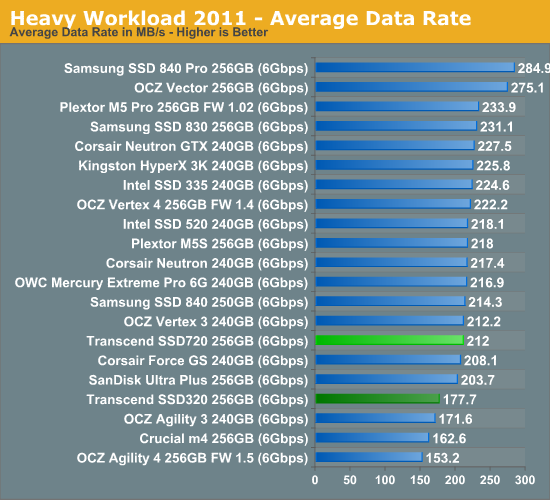
Our Heavy suite pretty much summarizes the results we saw in synthetic tests. The SSD720 is around 20% faster but most of the difference comes from its faster read speed, which is largely due to SSD320's poor read performance with incompressible data.
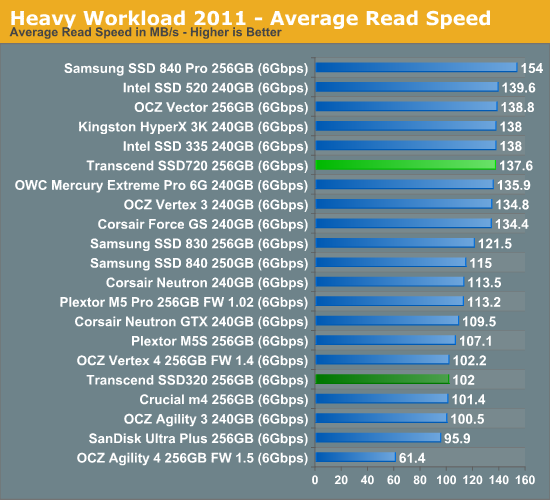
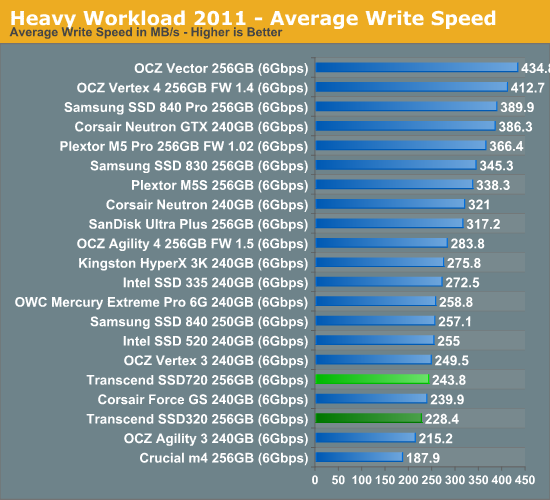
The next three charts just represent the same data, but in a different manner. Instead of looking at average data rate, we're looking at how long the disk was busy for during this entire test. Note that disk busy time excludes any and all idles, this is just how long the SSD was busy doing something:
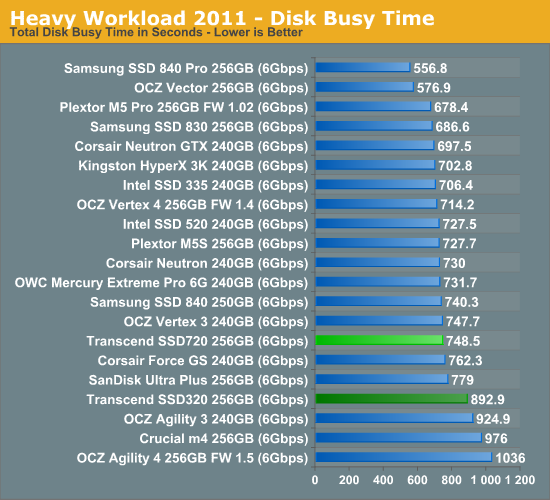
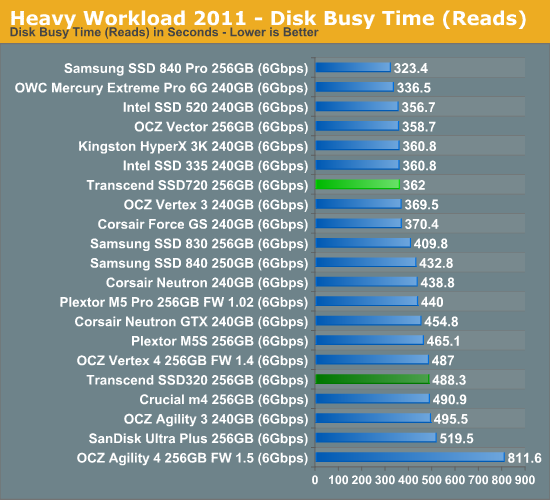
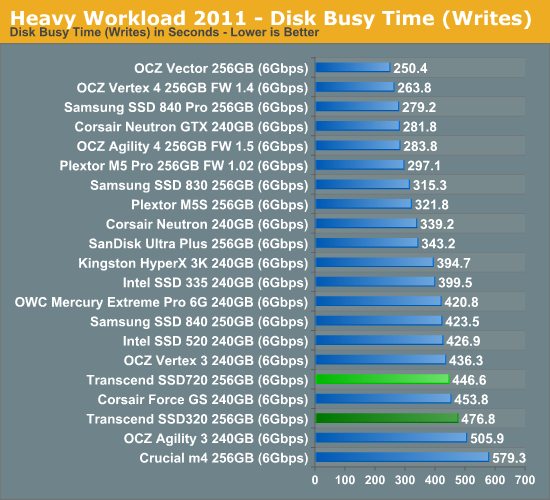










34 Comments
View All Comments
Beenthere - Saturday, January 26, 2013 - link
Many enthusiasts base their PC hardware purchases strictly on synthetic benches, which is laughable when many folks have no clue the benches are not necessarily accurate or representative of the actual performance of the hardware. It doesn't matter if it's an SSD, RAM, mobos, HDDs or other products, the benches can be very misleading.I defy anyone to accurately tell the difference in system performance in a blind test... between any popular SATA II and SATA III SSD, regardless of cost, when comparing the same size drives. The same goes for DRAM, I defy anyone to tell the difference in a blind test... between RAM running @ 1333 MHz. and @ 2000 MHz. in any Intel or AMD powered desktop PC. It's simply impossible to do though the uninformed will argue to their dying breathe but not actually run blind tests to prove it to themselves.
That being said, if you're willing to take a chance on lost data, regular firmware update requirements to fix issues, RMA's, etc. with an SSD, picking an SSD for most folks should be based on your needs, the SSD's reliability, compatibility, manufacturer reputation for warranty/service and price. FYI - Longer product warranties do not necessarily mean better quality drives be they SSDs or HDDs. You can completely forget benchmarks as they are for new, clean drives and mean nothing in the real world nor is the difference in system performance even discernible.
If you want a real good laugh - go to the major SSD maker websites and find the complete SSD warranty and read it carefully. Find out what your real cost/inconvenience/losses are if the SSD has a defect/fails. It ain't pretty... in many cases.
jason_mcallister - Sunday, January 27, 2013 - link
I really like your post and completely agree with your statements. I find it curious that more folks don't also see things this way. I was gullible in paying a premium for my DDR3-2400. If I had done some research before the purchase I would have realized that it wasn't a performance increase that I would have ever noticed. People, in which I include myself, are always looking at the benchmarks (metric tests) and kind of shut off the critical thinking process. Thankfully, I'm a little wiser these days and have a better process for making purchase decisions.alkhrt - Sunday, January 27, 2013 - link
It's great to see the price /GB close to $1., but 1TB worth of SSD ~$1000, while 1TB HDD ~$70. I can't believe with no moving parts etc. that SSD's are 14x more expensive to produce. Still feel like I'm getting the shaft buying one.Scour - Saturday, February 16, 2013 - link
The funny thing: The 320 was one of the cheapest 256GB-SSD at the arrival, only some old OCZ (240GB Vertex/Agilty 2, 256GB Petrol) were cheaper.Now it´s more expensive than M5S, M4 Hyper X 3k, Intel 335. OK, most SF-SSDs only offers 240GB, but for example the 335 ist about 14€ cheaper.
So I see no reason to buy a Transcend 320, my first choice in this class is the Plextor